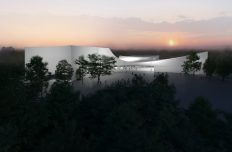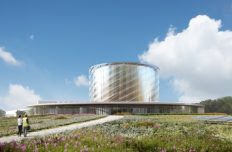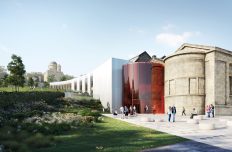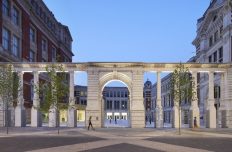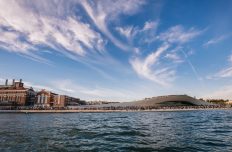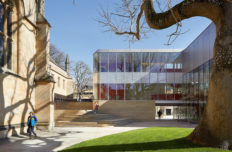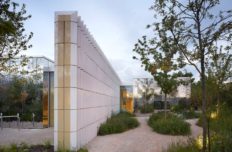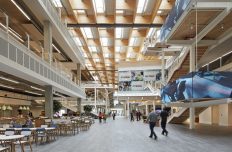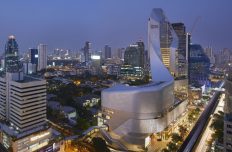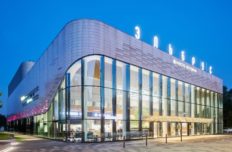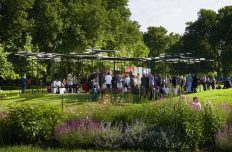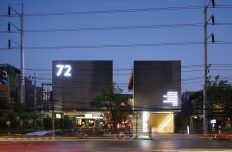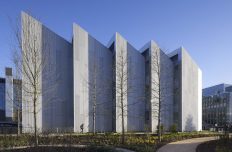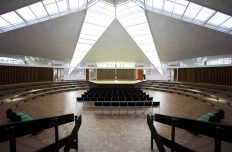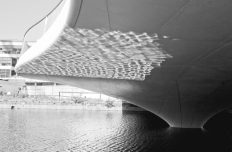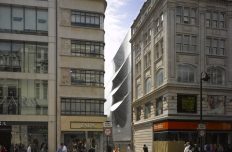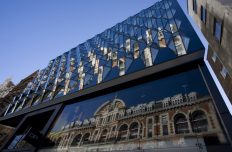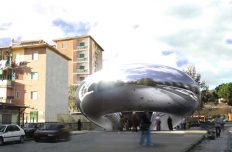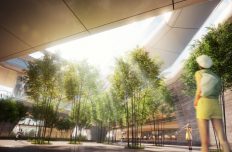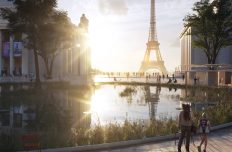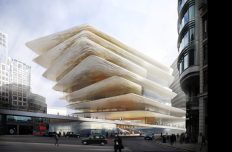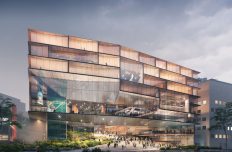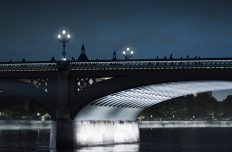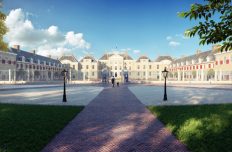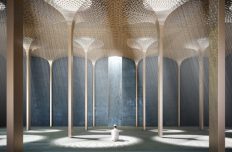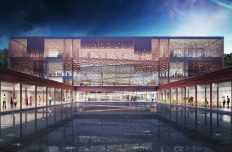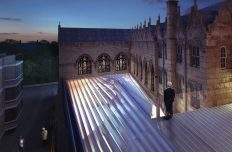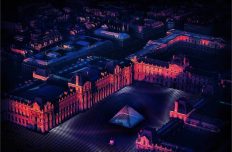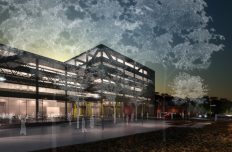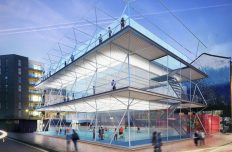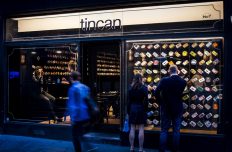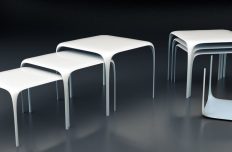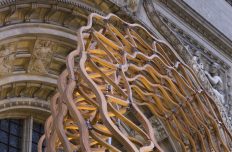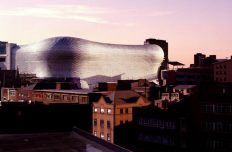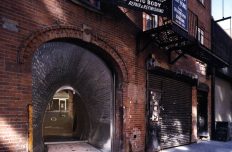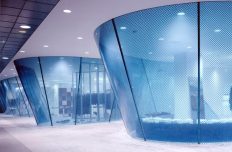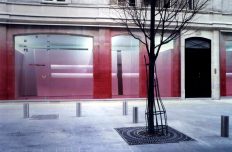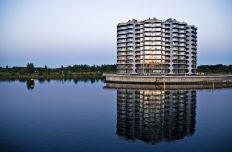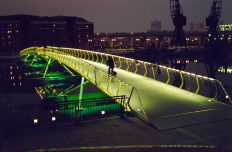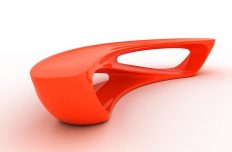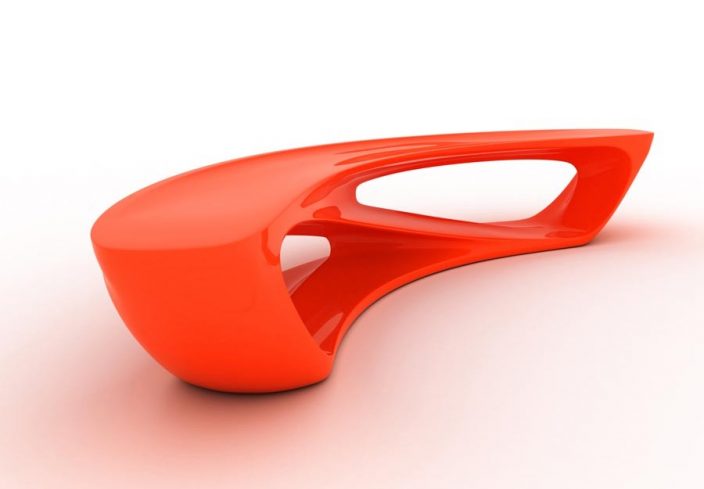
Furniture allows us to work at a different scale, to explore new opportunities for forms, materials and fabrication techniques. And the methods found in designing benches or light fittings impact on our architectural projects. The manufacture of the Drift bench influenced the construction of the Spencer Dock Bridge; our obsession with porcelain at the V&A led to an extension of our research in the shape of the Ceramic Table.
Drift
Drift came about after thinking of the bench as a line that has gently drifted backwards. We have used the same kind of language developed for Chester where the surface is modulated and carved to accentuate form. It is a seamless piece where the turbulence of the surface creates patterns of light and shadow on the oblique planes giving a dynamic force to the form.
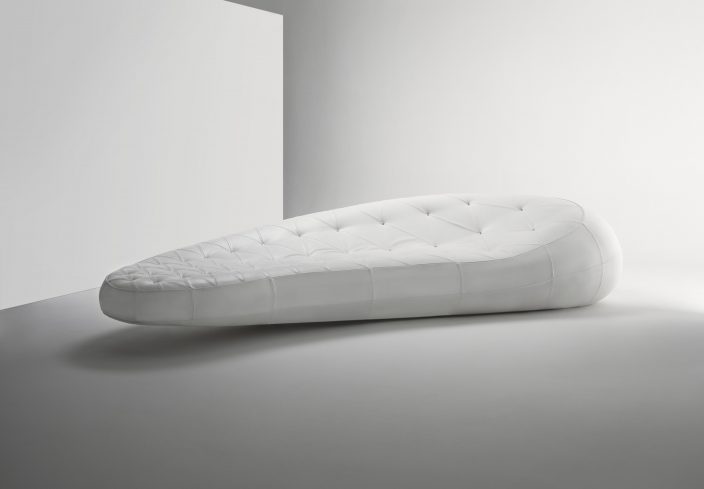
The Chester
The Chester found its inspiration in the traditional form and iconic nature of the Chesterfield sofa. The form was reworked and remodelled into an utterly contemporary design that employs the latest technology to create its organic form alongside the most time honoured skills of upholstered furniture manufacture.
Chester, the edition piece, is a somewhat lateral interpretation of the classic Chesterfield sofa, using traditional upholstering techniques with springs, horsehair and a buttoned leather skin to create a soft, feminine form.
Chester, the production piece, can be used as both a chaise and a sofa. The form is a soft bean shape that has been smoothed and sculpted to emphasise reflections. Low slung and constructed in two parts, the sleek fibreglass base is in contrast to the upholstered cushion insert.

Around the Corner
“The corners of a room are often lost spaces, rarely exploited for the display of either art or furniture. I wanted to address this with pieces specifically designed to take up these vacant spaces.” Amanda Levete
The pieces are about creating a spatial relationship between the corner and object – where the space in between is as important as the object itself.
Designing a piece to be installed where converging walls meet suggests a certain aesthetic complexity. Initial forms were derived from a complex three – dimensional formula that was manipulated digitally and then by hand to create elegant and functional pieces of furniture.
This language of interweaving and fluid forms was stretched to create surfaces that reveal both a top, sides and an underneath.
North, Console
This shockingly bright fibreglass console is the most immediately visually referenced piece in the collection. Finished in a glossy, electric, acid lime green, it is fixed on two sides and creates a shelf that folds into itself to create a vessel. The console casts shadow on itself, accentuating its visual complexity.
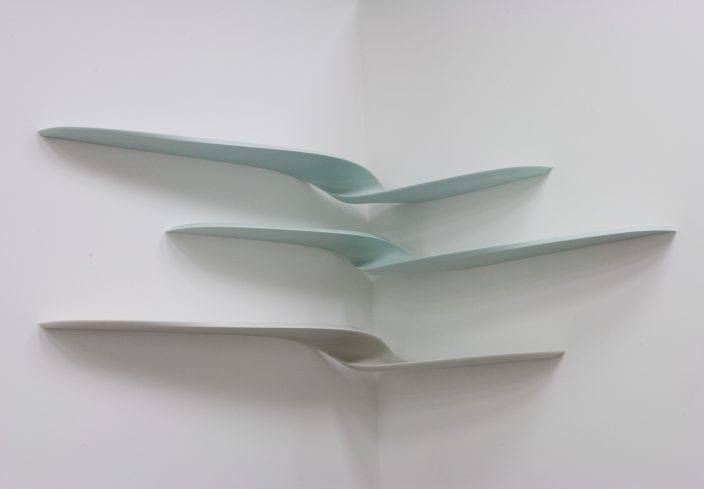
Around the Corner
“The corners of a room are often lost spaces, rarely exploited for the display of either art or furniture. I wanted to address this with pieces specifically designed to take up these vacant spaces.” Amanda Levete
The pieces are about creating a spatial relationship between the corner and object – where the space in between is as important as the object itself.
Designing a piece to be installed where converging walls meet suggests a certain aesthetic complexity. Initial forms were derived from a complex three – dimensional formula that was manipulated digitally and then by hand to create elegant and functional pieces of furniture.
This language of interweaving and fluid forms was stretched to create surfaces that reveal both a top, sides and an underneath.
South, Set of shelves
The South shelves, which are shown in sets of two, are twisted to rest against both sides of the corner. Made entirely of Corian, in both white and a pale blue, they make reference to classical architectural detailing. The surface is folded back on itself to allow the shelf to be reversed.
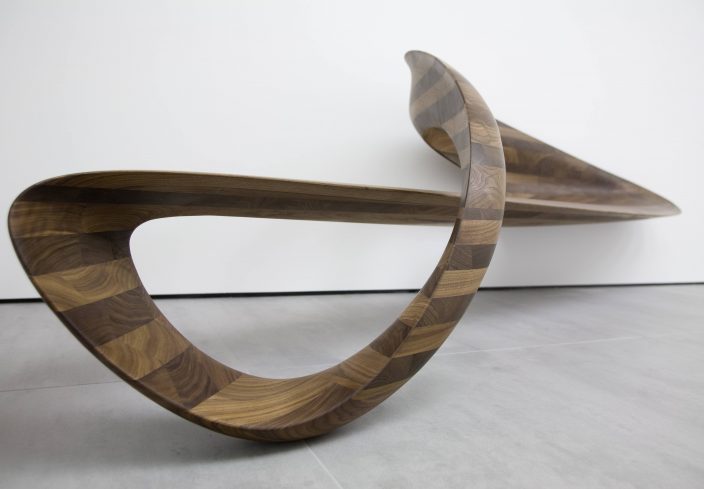
Around the Corner
“The corners of a room are often lost spaces, rarely exploited for the display of either art or furniture. I wanted to address this with pieces specifically designed to take up these vacant spaces.” Amanda Levete
The pieces are about creating a spatial relationship between the corner and object – where the space in between is as important as the object itself.
Designing a piece to be installed where converging walls meet suggests a certain aesthetic complexity. Initial forms were derived from a complex three – dimensional formula that was manipulated digitally and then by hand to create elegant and functional pieces of furniture.
This language of interweaving and fluid forms was stretched to create surfaces that reveal both a top, sides and an underneath.
West, Seating or bench
The West bench looks like an elegant calligraphic scrawl magnified into a three dimensional form and explores the relationship between solid and void. It is one continuous line that has been twisted, folded exaggerated and reduced so as to express the forces on the seat. The piece appears to be spontaneous but is the result of a complex design process. It is invisibly fixed to one side of the corner and gently touches the other side, where it comes to rest on the floor. It is made of high quality, laminated wood, like the deck of a yacht. The grain of the wood is revealed as it stretches, accentuating the curvature of the form.
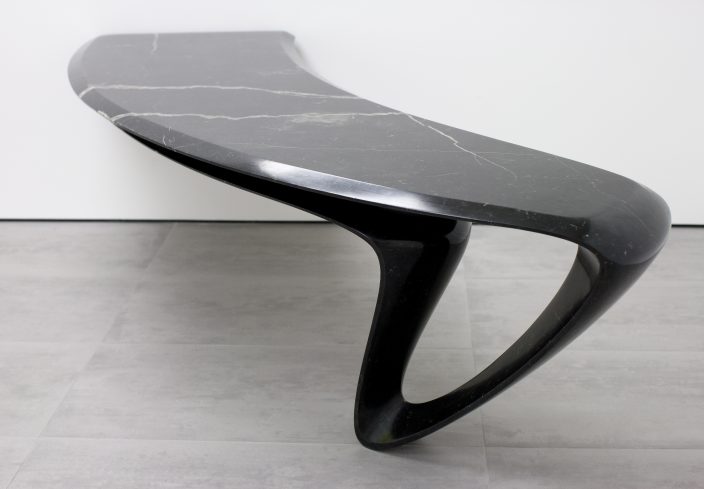
Around the Corner
“The corners of a room are often lost spaces, rarely exploited for the display of either art or furniture. I wanted to address this with pieces specifically designed to take up these vacant spaces.” Amanda Levete
The pieces are about creating a spatial relationship between the corner and object – where the space in between is as important as the object itself.
Designing a piece to be installed where converging walls meet suggests a certain aesthetic complexity. Initial forms were derived from a complex three – dimensional formula that was manipulated digitally and then by hand to create elegant and functional pieces of furniture.
This language of interweaving and fluid forms was stretched to create surfaces that reveal both a top, sides and an underneath.
East, Corner table or desk
Carved mechanically from one piece of black marble then finished by hand, North looks like an almost impossible feat of engineering. The table is a looped form that frames the void within it. The marble is as slender as it is possible to be at one point thus creating a long, free span strengthened in the middle by merging the two surfaces.
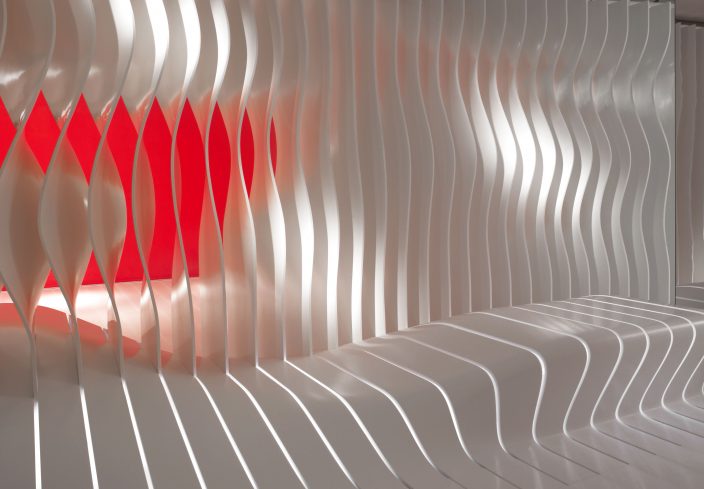
Corian Lounge
A drop of water creating a series of ripples became the metaphor for transforming space through movement. Just as the ripple causes intricate moiré patterns in water, the Corian® Super Surfaces lounge is about revealing the moment of change through visual complexity, creating dynamic kinetic effects. Moving through the space appears to animate it. Views are revealed and concealed as the surfaces transition between active and passive states creating countertops, display shelving, seating and a partition that seamlessly morphs from solid to transparent.
More than just an expression of the material, the surface transformations push the technical possibilities of DuPont Corian® by exploiting its pliability and using the twisted geometry of the sheets to bring structural integrity. Advanced digital technology was used as part of the process for generating the design as well as for the fabrication of the installation. AL_A also designed the making of the piece, working closely with Hasenkopf to develop a single adjustable jig that created multiple twisted surfaces from a standard flat sheet.
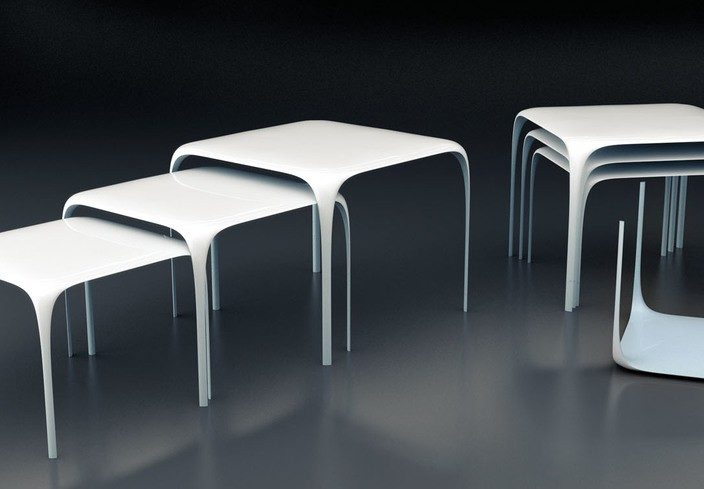
Ceramic Table
Ceramique, a table designed by AL_A, challenges perceptions of materiality and structure, history and modernity. It is the world’s first piece of furniture to be crafted in silicon carbide, a high-tech ceramic more commonly used in aerospace industries. Ceramique began in the ceramics collection of the V&A. This inspired AL_A’s design for a porcelain courtyard, part of their project for the new galleries on Exhibition Road, necessitating extensive research into ceramics’ potential. The result of eighteen months’ exploration, Ceramique examines a material’s capability to give an everyday object new meaning by turning processes at technology’s frontiers into something seemingly ancient, fired with a traditional crackled glaze.
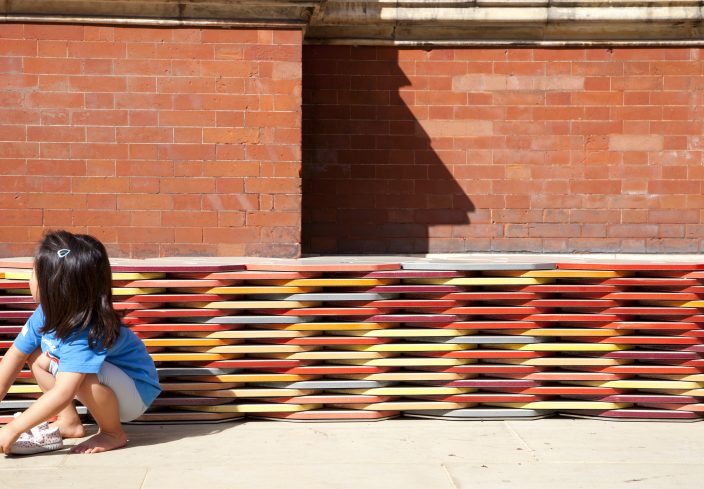
Bench of Plates
Ceramic is a material embodying thousands of years of human endeavour. Raw and of the earth, the first material to be machined and tamed by man is still in everyday use. Tough but ultimately vulnerable, its antiquity belies its enduring and timeless modernity.
Beauty and utility are at the heart of ceramics’ lasting appeal. We have worked in partnership with Ceramica Cumella to showcase glazes, the spectrum of colours playfully referencing the domestic crockery that has served dinner tables for millennia. The individually hand-made components can be read as plates, tiles or shingles, a poetic repurposing of the material’s traditional uses.
Repetition of a single motif creates visual complexity but also a modular system interlocking in both plan and section, each plate providing support for its immediate neighbours. It is adaptable, changing shape with each new installation to respond to its context, environment, users and function.
The V&A is home to the world’s finest ceramic collections which inspired our design and choice of material.
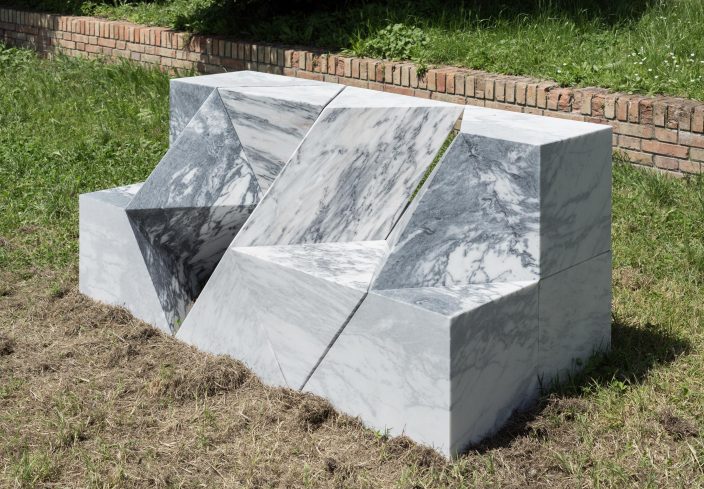
Metamórfica
At a macro level, marble is a resistive, metamorphic stone, strong in compression. At a micro level, it is a complex structure composed of innumerable calcite crystals. Our proposal, Metamórfica, aims to celebrate these material properties.
When fully assembled, Metamórfica is a perfect cuboid. It is a simple, monolithic and stable form. Its surface is rough and unpolished, seemingly fresh from the quarry, but beneath this unrefined façade lies a beautiful and complex composition of nine marble fragments. The disassembly process reveals that the interior facets of these fragments are smooth and highly polished. This refined finish, coupled with the triangulation that facilitates the interlocking system, bridges the gap between stone and crystal. Each piece has the potential to be appropriated in different ways, with suitable dimensions for stools, coffee tables and benches.
To reinforce the concept of parts coming together to form a homogenous whole, all the pieces are cut from the same Portuguese marble, Pele Tigre. It is white in colour, with a thin to medium grain and irregular blue-grey veins.
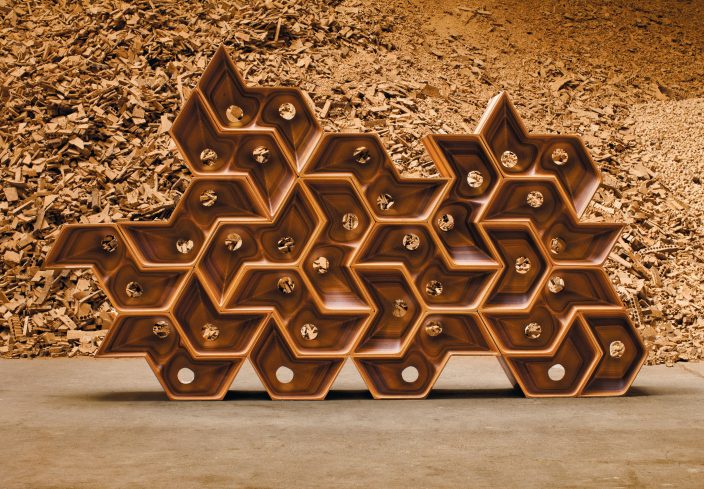
Cork Kit
The design of the cork kit explores the boundary between material, process and design. The piece exploits the natural characteristics of cork by emphasising its lightness and colour tonalities to create a modular, self supporting assembly system.
We used a baking process to reveal the colour strata running through the body of the cork without additives. But to give an even richer reading of the material, we added a layer of complexity, experimenting with the baking times to achieve 13 different colour tones. The tonal range is then expressed as a gradient running from light to dark.
A circular hole reduces the weight of the pieces, allows light through and increases the surface area for sound absorption. Left over pieces from the machining process are recycled as cork granules so achieving zero wastage.
The geometry of the two module types is designed to be interlocking and self supporting. Light enough to be lifted by one person, each module can be arranged in multiple configurations, to be used as a partition, a screen, sound proofing or occasional furniture. Smaller scale modules are designed for use by children.
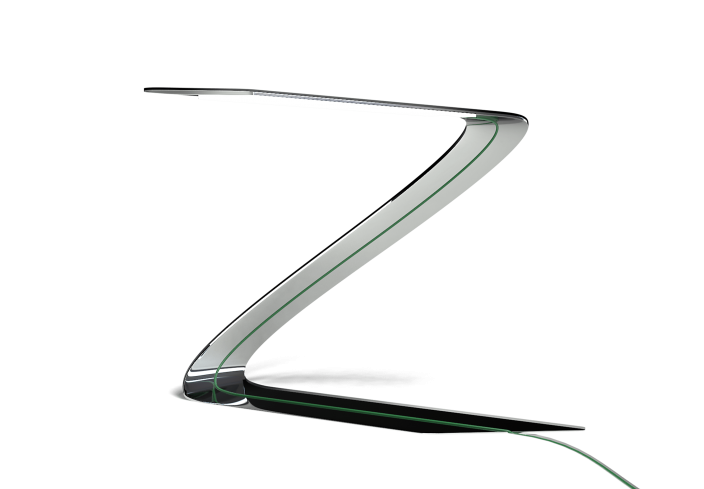
Edge Light
Edge is driven by the desire to exploit a new technology that is destined to change the way we see light. OLED is an extremely flat, lightweight panel of light that works by passing current though electrodes embedded in a clear film. We wanted to reveal the wafer thin essence of OLEDs and create a light that is completely reductive in its simplicity. A flat ribbon of steel is twisted into a self-supporting form. A groove is then cut into the steel, off centre, to allow the cable to be expressed and to reflect the line of movement in the piece.
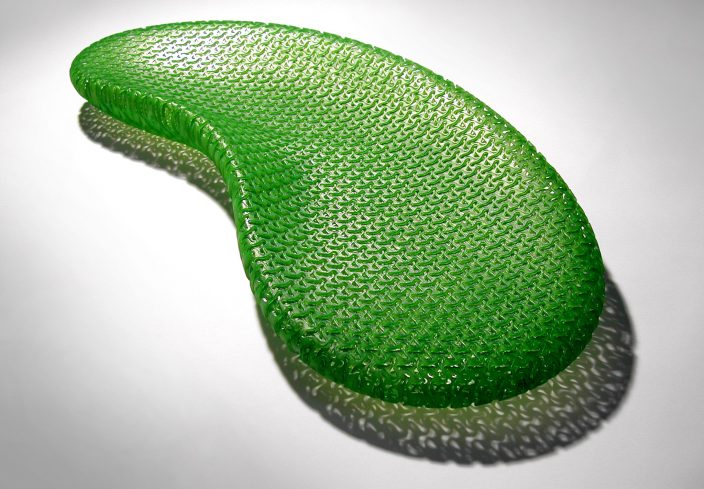
Fruit Bowl
The fruit bowl is derived from a soft bean-shape motif that is a recurring theme in our architecture. The SLS process allowed us to explore the natural distortions that occur when a complex 3-dimensional form is stretched. To add stiffness and further complexity we created a double layered skin that overlaps to produce a moiré effect in nylon.
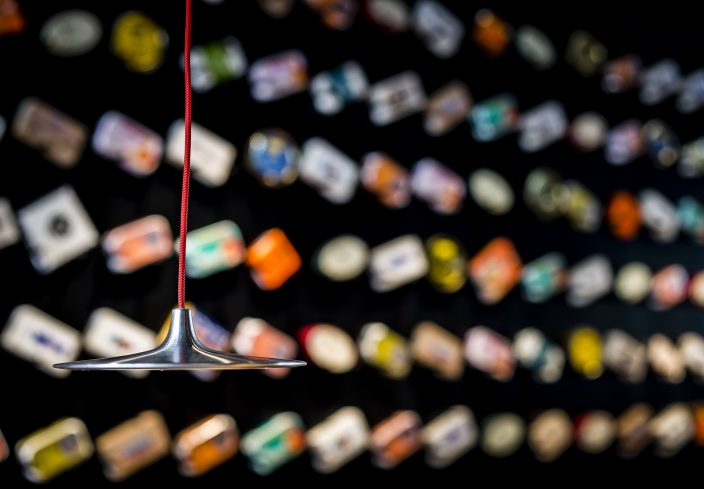
Soho Light
Exquisitely delicate and wafer thin, the Soho pendent light was created for a pop-up restaurant project in London’s Soho, serving the best tinned seafood in the world.
Designed to showcase pioneering OLED technology, the ultra-slim 1mm thick circular light source is enclosed within a discrete spun aluminium casing to form an elegant pendant light, suspended by simple red wires.
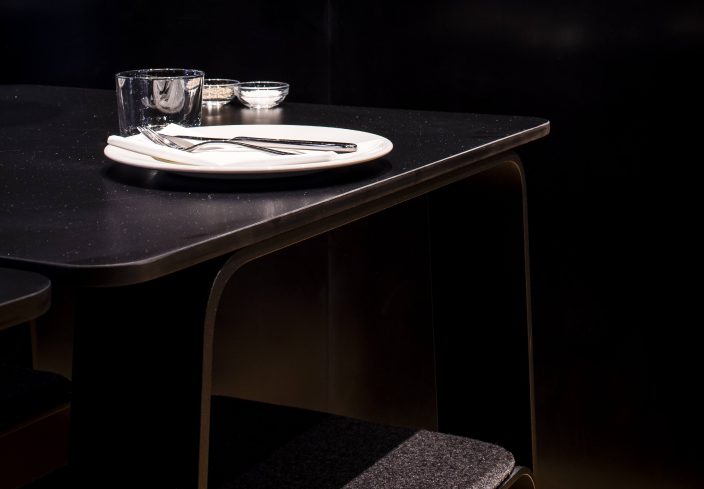
Tincan furniture
Alongside the Soho light, AL_A worked with collaborators to design stackable aluminium stools and tables made by Iduna of Portugal, and walls in black Corian® as a backdrop to display the iconography of the tinned fish packaging.
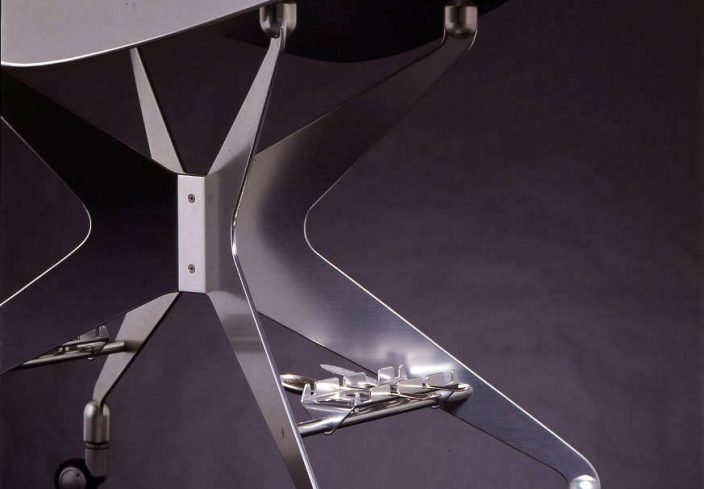
Ivy Trolley
The trolley is designed to be as streamlined and minimal as possible in order to fit between the tables and for ease of manoeuvrability. The sculptural qualities of the legs and serving plate are emphasised and the traditional lower shell is eliminated with the cutlery suspended between the legs and doubling as bracing for extra stability. Chromed plastic ribs are inserted into the work surface to prevent plates rattling and to avoid the need for the usual linen cover. All the elements are cut from a 6mm aluminium sheet, anodised and simply bolted together.
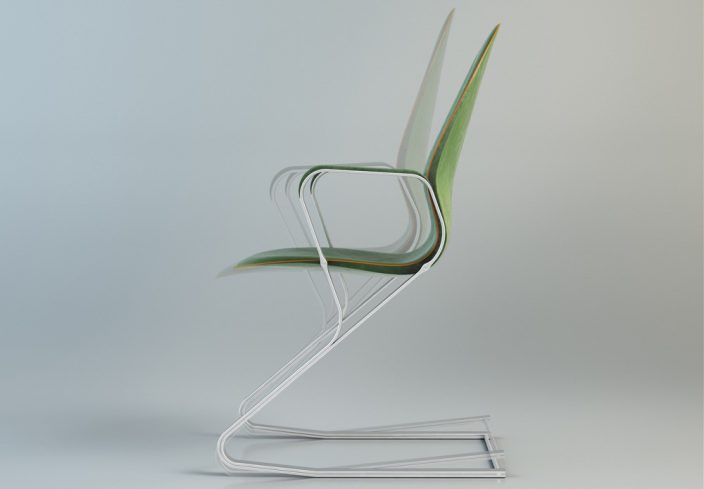
Bodleian Libraries Chair
For a library where ancient manuscripts cohabit with laptops, the chair must allow readers to move freely from relaxed to interactive. Derived from three simple curves, this elegantly profiled, ergonomically sophisticated, dual position chair is fabricated from a compressed natural fibre shell, held in position by a stainless steel frame and upholstered in leather.
Furniture allows us to work at a different scale, to explore new opportunities for forms, materials and fabrication techniques. And the methods found in designing benches or light fittings impact on our architectural projects. The manufacture of the Drift bench influenced the construction of the Spencer Dock Bridge; our obsession with porcelain at the V&A led to an extension of our research in the shape of the Ceramic Table.
Drift
Drift came about after thinking of the bench as a line that has gently drifted backwards. We have used the same kind of language developed for Chester where the surface is modulated and carved to accentuate form. It is a seamless piece where the turbulence of the surface creates patterns of light and shadow on the oblique planes giving a dynamic force to the form.

